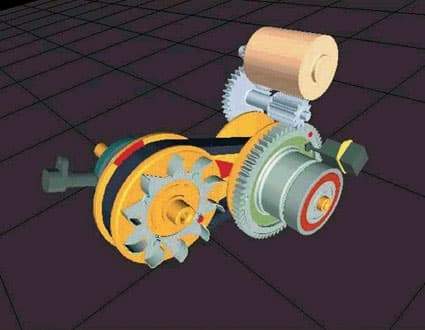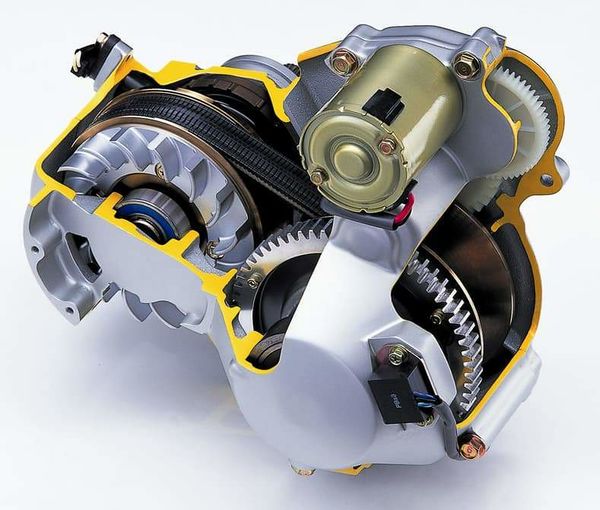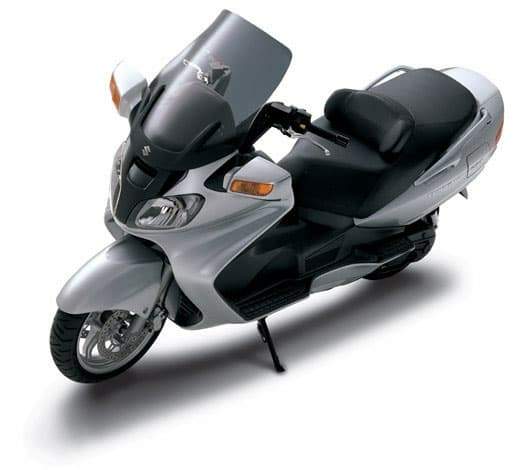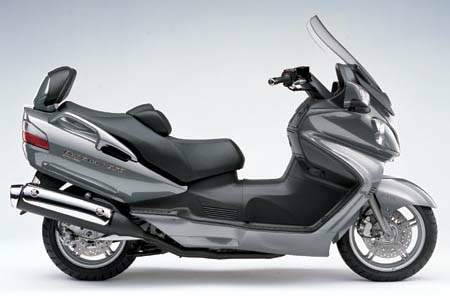Suzuki AN650 Burgman Exclusive
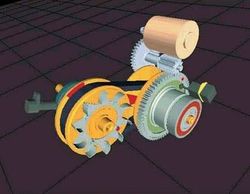 |
|
| Suzuki AN650 Burgman Exclusive | |
| Manufacturer | |
|---|---|
| Production | 2004 |
| Class | Scooter |
| Engine | Four stroke, twin cylinder, DOHC, 4 valves per cylinder. |
| Compression ratio | 11.2:1 |
| Top Speed | 177 km/h / 110 mph |
| Ignition | Digital electronic |
| Transmission | Electronically-controlled, CVT- automatic |
| Frame | Tubular steel |
| Suspension | Front: Telescopic front fork with 41mm inner tubes Rear: Swingarm-style, twin preload-adjustable shock absorbers and a separate aluminum swingarm |
| Brakes | Front: 2x 260 mm discs, 2 piston calipers Rear: Single 250 mm disc, 2 piston caliper |
| Front Tire | 120/70 R15 |
| Rear Tire | 160/70 R14 |
| Seat Height | 750 mm / 29.5" |
| Weight | 238 kg / 525 lbs (dry), |
| Recommended Oil | Suzuki ECSTAR 10w40 |
| Fuel Capacity | 15 Liters / 4.0 US gal |
| Manuals | Service Manual |
It could reach a top speed of 177 km/h / 110 mph.
Engine[edit | edit source]
The engine was a Liquid cooled cooled Four stroke, twin cylinder, DOHC, 4 valves per cylinder.. The engine featured a 11.2:1 compression ratio.
Chassis[edit | edit source]
It came with a 120/70 R15 front tire and a 160/70 R14 rear tire. Stopping was achieved via 2x 260 mm discs, 2 piston calipers in the front and a Single 250 mm disc, 2 piston caliper in the rear. The front suspension was a Telescopic front fork with 41mm inner tubes while the rear was equipped with a Swingarm-style, twin preload-adjustable shock absorbers and a separate aluminum swingarm. The AN650 Burgman Exclusive was fitted with a 15 Liters / 4.0 US gal fuel tank. The bike weighed just 238 kg / 525 lbs.
Photos[edit | edit source]
Overview[edit | edit source]
Suzuki AN 650 Burgman Executive
It's a scooter to look at, but the 650cc, fuel-injected motor and electronically-controlled continuously variable transmission of the Suzuki Burgman offer far more than the styling would suggest. When one thinks scooters, the first thought is immediately one of a small capacity machine designed for inner city commuting applications.
The Burgman is very different machine, although it visually shares the same form factor.
For starters, with a high-tech 638cc motor, it is powerful and comfortable enough for touring on the open road, which separates it from traditional scooters by a few light years. It's not so much the machine but the SECVT which really impressed me.
The electronic gearbox is a foretaste of the future of commuting machinery and quite possibly of motorcycling in general. Manual Mode offers the ability of shifting up and down as on a motorcycle with a traditional gearbox and there are five pre-determined CVT ratios to shift through.
If there is a drawback with the bike, it's that the manual shift doesn't offer the same thrill of snicking it up a cog and dropping the revs back into the meat of the torque curve as you would with a normal motorcycle.
Put simply, in manual mode, it's like a tiptronic-style manual gearbox for a two wheeler, and the gears can be changed by thumb. Almost the whole time we had the machine, we used the automatic mode, because it offered continuously smooth automatic operation, the utmost convenience and almost no downside. And we found that the manual mode offered almost no advantage and was devoid somehow of that satisfying snick, so seamless is the Burgman power delivery. You push the button and it changes gear.
There are two automatic modes: Normal and Power. In Normal Mode, the Burgman runs lower revs at any given road speed, conserving fuel and loping along in the traffic. Most scooters "buzz" or "scream" along - the Burgman "lopes".
Switch to Power Mode and engine revs pick up, delivering more ponies per degree of throttle opening. A button on the handlebar toggles between the two modes. It's ironic indeed that the array of devices which once graced motorcycle handlebars (advance-retard lever, choke, and decompression lever for starting) and were dispensed with thanks to technological advances, have now been replaced with a modern-day equivalent. Just the same, adept minds accustomed to using game controls had no trouble mastering the buttons in short order - it was only the older heads who took a bit of time to adjust.
Now there's a point where being on a scooter is great, such as when it rains or when you need to store something. But there are other times when being on a scooter is not so great.
It was clear after riding the bike for a couple of weeks, that many of motorcycling's brethren do not accept scooter riders as legitimate members of the two-wheeled fraternity. Pull up at the lights and nod to another two-wheeled commuter and the chances of getting a warm reply are greatly diminished if you are on a scooter. It was quite strange really, particularly after years of riding everything at the testosterone end of motorcycling, and something we all noticed when riding either the Burgman or the Benelli Adiva. In motorcycling's pecking order, scooters are seemingly on the bottom rung!
This rampant "scooterism" has a sure-fire cure when riding the 650 Burgman - hit the power button and nail it the millisecond the lights go green.The get-up-and-go of the Burgman over the first 50 metres embarrassed a couple of litre-plus bike riders and positively humiliated a Harley Sportster rider who rode through a red light rather than face the Burgman a second time at the traffic light grand prix. The "magic button" is conveniently located on the handlebar panel and it aids the Burgman in producing very spirited performance indeed.
The SECVT system uses a set of variable-diameter pulleys and a new type of belt called the Dry Hybrid Belt, which is built using rubber tension members embedded in H-shaped, high-strength aluminum blocks covered with resin.
Lightweight and designed to run dry (instead of an oil bath which increases frictional losses), the belt is the secret to the incredible precision of the Suzuki CVT. A computerized SECVT controller and ECM oversee the SECVT's operation. They calculate the actual CVT ratio by using three sensors: a drive pulley position sensor, which senses the drive pulley diameter from the position of a slide gear; a crank position sensor; and a CVT rev sensor on the driven pulleys. Based on road speed and throttle position, the SECVT controller calculates the target engine rpm and automatically adjusts the CVT ratio by varying the drive pulley diameter.
Using the transmission is a complete no-brainer, making it the ideal first bike - the rider can learn roadcraft instead of worrying about clutches and changing gears and the power is smooth and broad and you'll never find yourself in the wrong gear at the wrong speed. The Burgman is a great learner machine!
One of the best things about the Burgman is its luggage and storage capacity: the under-seat storage compartment measures a full 56 liters, which is plenty large enough for most commuting and day trips. The great thing about the design is that you can take out your books/bag etc and leave two full-face helmets inside.
The Burgman also has the feel of a luxury car in that it is extremely well appointed there's a light in the storage compartment which switches on automatically when you lift the seat, illuminating the entire area, reminiscent of BMW-style thoroughness. The front fairing contains three compartments which became incredibly useful having a glove box on a motorcycle is far more useful than in a car!
The luxury feel extends also to the seat - the thickly padded seat is expansive and ergonomic and according to Suzuki, it is designed for two people to be able to sit comfortably for long stretches. The rider's seat height is just 750mm and is hence quite suitable for shorter people and there are several adjustments to the seat and backrest which can be quickly done under the seat without resorting to tools.
The concave floorboards offer plenty of room for two sets of feet, and the absence of a gear-lever means that you can arrange yourself into several different riding positions, from the full feet-forward chopper-style riding position, through to tucking the feet underneath. It's great to be able to move about a bit if you've been in the saddle for a few hours.
The luxurious and modern impression of the Burgman also extends to the instrumentation, with the digital instrument panel cluster offering all the key operational information and then some. At the centre is a large, central LCD speedometer, odometer, tripmeter and oil change indicator. Directly above is a curved LCD-segment tachometer; directly below is a shift indicator, showing D for fully automatic operation and 1-2-3-4-5 for manual shifting operation.
To the sides are a segmented water temperature meter, a segmented fuel level meter, a clock, and key indicator lights. The Burgman 650 is also equipped with a DC accessory outlet, which can be used to power or recharge a mobile phone, PDA or other electronic device.All-in-all, the Burgman is a gem a glimpse into motorcycling's future. At some point in the future, a lot more vehicles will have the benefit of a CVT, and they won't all be scooters.
| Make Model | Suzuki AN 650 Burgman Executive |
|---|---|
| Year | 2004 |
| Engine Type | Four stroke, twin cylinder, DOHC, 4 valves per cylinder. |
| Displacement | 638 cc / 38.9 cu in |
| Bore X Stroke | 75.5 x 71.3 mm |
| Compression | 11.2:1 |
| Cooling System | Liquid cooled |
| Induction | Electronic fuel injection |
| Ignition | Digital electronic |
| Starting | Electric |
| Max Power | 40 kW / 55 hp @ 7000 rpm |
| Max Torque | 62 Nm / 6.3 kgf-m / 45.7 lb-ft @ 5000 rpm |
| Transmission | Electronically-controlled, CVT- automatic |
| Final Drive | V-belt |
| Frame | Tubular steel |
| Front Suspension | Telescopic front fork with 41mm inner tubes |
| Rear Suspension | Swingarm-style, twin preload-adjustable shock absorbers and a separate aluminum swingarm |
| Front Wheel Travel | 105 mm / 4.1" |
| Front Brakes | 2x 260 mm discs, 2 piston calipers |
| Rear Brakes | Single 250 mm disc, 2 piston caliper |
| Front Tire | 120/70 R15 |
| Rear Tire | 160/70 R14 |
| Seat Height | 750 mm / 29.5" |
| Dry Weight | 238 kg / 525 lbs |
| Fuel Capacity | 15 Liters / 4.0 US gal |
| Top Speed | 177 km/h / 110 mph |
| ¼ Mile Acceleration | 16 sec |
| Review | Gizmag |
